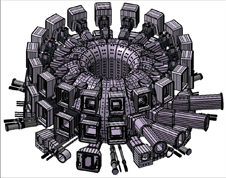March 31, 2010 Vol. 3, Issue 3
Like space exploration, mega-projects in the world of particle physics and energy research depend on international collaboration.
The Large Hadron Collider and the ITER nuclear fusion reactor are two of the leading “big science” international collaborations in progress today. Here are snapshots of the complexity of each project.
A “Compact” Muon Solenoid

View of the CMS detector. Image Credit: CERN
The Large Hadron Collider, a 17-mile-long behemoth running 500 feet under the French-Swiss border, has made headlines as a model of international collaboration. One of the colliders six experiments is the Compact Muon Solenoid (CMS), but theres nothing compact about it.
CMS is one of two detectors searching for the Higgs Boson particle and dark matter. It weighs 12,500 tons (the equivalent of 30 jumbo jets) and includes a 4-Tesla magnetic field (100,000 times stronger than that of the Earth). It consists of fifteen 2,000-ton slices resembling 50-foot roulette wheels turned on their sides.
The CMS team learned lessons from previous CERN experiments like the Large Electron Positron (LEP) Collider. For instance, the detector should be built above ground rather than in the cavern below. While this required the assembly and operation of a very large and strong crane to lower the components into the tunnel, it saved time and money, and made a safer instrument. Additionally, the CMS team learned from LEP that the subsystems within CMS should be easily accessible for repairs and maintenance.
The CMS team includes 1,800 physicists from 147 institutes and 32 countries. The most common challenges they face include the distribution of computing resources, remote software development and physics analysis, and proximity to team members. But they also have encountered challenges that have resulted in unexpected solutions.
The Russian team was responsible for supplying 600 tons of brass required to construct the end caps on HCAL. To deliver such a large quantity of brass that would meet the manufacturing requirements of the project, Russian engineers negotiated a deal with the Russian Navy to melt down over a million brass shell casements from World War II. Despite this effort, the brass from the recycled shells did not provide the full amount necessary for the end caps. The United States provided the Russian team with $1 million of copper, one of the two elements in brass. This solution, worked out on a handshake basis, enabled the Russians to meet the requirement and enhanced cooperation and mutual trust.
One instrument within CMS is the Hadron Calorimeter (HCAL). HCAL is a subsystem designed, developed, and assembled by countries including India, Bulgaria, Turkey, Russia, and the United States. This subsystem measures the energy of hadrons (a class of particles).
The project relies extensively on cooperation from industry. Hamamatsu Photonics turned over one of their production lines to the CMS team so they could build sensors needed for the detector. In the end, the assembly of CMS was successful because all sides understood each other’s strengths and weaknesses, and all did what they had to in order to get the job done.
Learn more about the Compact Muon Solenoid and its other subsystems.
The ITER Tokamak

The ITER Vacuum Vessel, which houses the fusion reaction and weighs 8,000 tons, slightly heavier than the Eiffel Tower. Image Credit: ITER Organization
The International Thermonuclear Experimental Reactor (ITER) tokamak (a Russian word referring to a donut-shaped chamber used for fusion research), is slated to begin construction in Cadrache, France this year. Its goal is to produce fusion energy, and it is being described as “one of the most innovative and challenging scientific projects in the world today [that is] also a prototype for large scale international collaboration in science and technology.”
The ITER tokamak has its origins in conversations that took place between President Reagan and Soviet leader Mikhail Gorbachev in Geneva in 1985. It would be another twenty years before the ITER team formed.
The ITER team started with seven members from seven nations (China, the European Union, India, Japan, Korea, Russia, and the U.S.), with each being equal to the others. All decisions made on the project are reached by consensus. Today the organization has grown to nearly 400 members and 20 nations, and all information, decision-making, and cost is shared among them. The team is unique in that nearly all components of the reactor will be provided by contributions from the seven member nations.
Construction on ITER begins this year. It will involve 300 convoys over five years carrying components at slow speeds in the middle of the night. The roads and bridges they will travel have to be modified to sustain weights of up to 900 tons. The reactor is expected to produce results before 2020.





